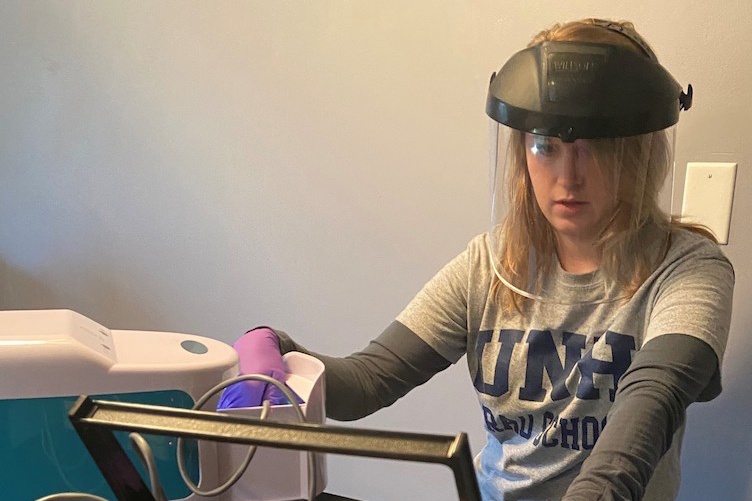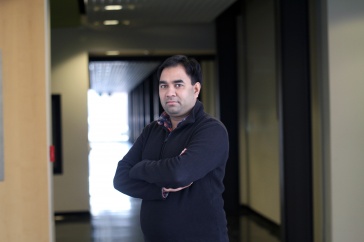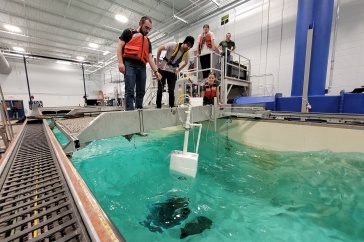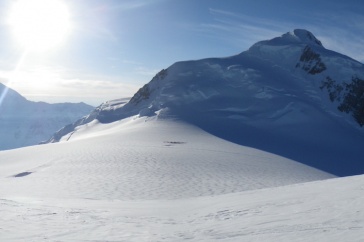
One morning during the first week of April, graduate student Castine Bernardy entered a deserted parking lot in Maine and pulled up beside an empty car whose back hatch was raised. Professor Jim Malley watched from a distance as Bernardy retrieved the lab supplies he had left for her in his car.
Such is the life of researchers in the age of the coronavirus.
Bernardy is conducting research on ultraviolet disinfection for Malley in the basement of her home. Earlier this year, she was in the Netherlands, working on a wastewater reuse project, when the coronavirus hit. Initially, she sheltered in place and continued doing her research. But as concerns about the virus grew, the project was canceled, and she returned to the U.S.
Her findings are informing both a national and international group of UV researchers.
“I was only in the Netherlands for a month and then, due to the coronavirus, my project completely fell apart,” says Bernardy, who was scheduled to stay overseas until September. “Coming home meant that I would have to completely start over with a new research project.”
In the meantime, Malley was fielding questions from medical professionals about the possible reuse of N95 face masks after UV disinfection. The professor of civil and environmental engineering at UNH is an expert on the use of chemical and physical methods, in particular ultraviolet light, to disinfect water, air and surfaces from bacteria, viruses and protozoan cysts. Since the onset of COVID-19, he has been advising medical practitioners and first responders around the country on using UV light to sanitize masks worn as protection against the virus.
“Castine was game to help with our research right away, so she joined my UV disinfection work on treating N95 masks for reuse by healthcare, laboratory and first responders,” Malley says. “She is now set up in her mom’s basement taking measurements of UV fluence (irradiance) on a UV disinfection device and using her computer to do mathematical modeling.”
Of the four graduate students Malley oversees, Bernardy is the only one doing UV related research. He notes that while germicidal UV (technically called UVC) or a shorter wavelength higher energy version termed "far-UVC light" can be effective for disinfecting masks and other personal protective equipment, it can be extremely damaging to human skin and tissues if applied under the wrong conditions or for extended durations.
“In general, physical or chemical methods that are made to disinfect or kill organisms whose molecular building blocks (DNA, RNA, proteins, lipids) are not that much different than ours should be treated by the public the same way they treat poisons,” he says.
Bernardy, who received her undergraduate degree in civil and environmental engineering from UNH in 2019, is conducting her research on several small UV devices, two radiometers that read UV light, and masks. She wears gloves and a face shield to protect herself from the UV light.
“Currently there is a model that was made to determine the UV dose, but it is not very accurate. I am collecting real data and comparing it to the model,” she says. “Once I do this I will then figure out how to correct the model. After the coronavirus finally subsides, the need for this work will not disappear, as it is our hope that it will be useful to determine UV dosages for other products.”
Malley says he applauds Bernardy for being flexible and rising to the occasion during difficult times, adding that her findings are informing both a national and international group of UV researchers.
“Castine was appointed as the youngest member of the International UV Association’s COVID-19 task force. Sometimes her long workdays can by bolstered by the email thank yous from medical professionals and staff across the U.S. who are taking her findings and putting them into use every day on the frontlines in the fight against COVID-19 ,” he says. “She is a great example of what UNH can offer our hardworking students during extraordinary times.”
-
Written By:
Jody Record ’95 | Communications and Public Affairs | jody.record@unh.edu



















































